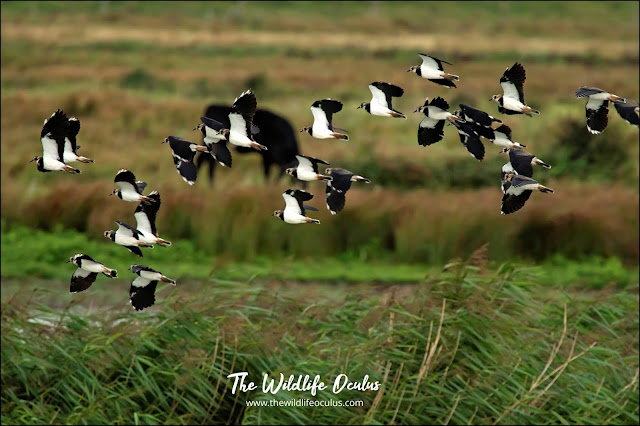All in a flap
 |
| Lapwings "All in a flap" |
I am now in my third year of visiting the reserve "regularly" - contrary to popular belief I am not living in a tent on-site ( but many times I wish I did ). I have never found two days to be alike. It can be the weather that changes, the tide changes, the bird's change, and the people change. It's difficult to predict exactly what to expect. Many people ask me whats the best time to visit. I usually say early or late in the day and when there is a high tide. This kind of rule of thumb though is quite unreliable as sometimes when even the planets seem to have all aligned and you think there is going to be a great bird show waiting for you when you turn up things end up being on the quiet side. But that's the nature of things and the unpredictability is all part of the fun of it and makes it exciting every time I visit as I just don't know what may turn up.
Yesterday the weather was pretty wet and windy with an enormous spring tide. There was a great showing of birds most notably Curlew Sandpipers and Sanderlings mixed in with big flocks of Dunlins and Ringed Plover. The Godwits and Knots put on a great aerobatic display which made up for the no-show of the Pectoral Sandpiper ( well for me anyway - it made an appearance later in the day like a lazy teenager).
I was expecting something similar today but it was surprisingly on the quiet side. There were a lot of visitors today. Probably attracted to by the prospect of seeing a Pectoral Sandpiper. Again I was disappointed as the bird yet again did not show up.
I spent a lot of time today in the Marsh Platform watching the flock of Black Tailed Godwits. They were huddled together out of the wind on Priors Lagoon. In with the flock was Knot, Redshank and a Ruff. In the gap between the central reeds, a Greenshank tentatively began to feed amongst a flock of Lapwings.
 |
| Startled Knots return to the flock |
 |
| Greenshank |
I love Lapwings. They are amazing looking waders, very colourful and possessing distinctive fan-like wings. They were quite happily feeding away calling "peewit" to each other as they did so when suddenly something startled them and they all rose into the sky "all in a flap".
 |
| The Lapwings return |
They all kept close together forming a band of birds that slowly circled upwards, higher and higher until they were back spots in the sky. This sort of behaviour is a defensive manoeuvre to avoid predators such as Peregrine Falcons.
Soon they were completely out of sight. Then after about ten minutes they slowly descended back to the lagoon to settle.
The panicked lapwings also startled a small flock of Knots and Shoveler ducks which proceeded to circle Priors whizzing through the skies until things calmed down.
 |
| Shoveler Ducks take flight |
For me, that was about the best part of today's visit. I love the aerial stuff. I like taking pictures of what birds do best - flying. There was an air of calm all over the reserve. I saw a Common Sandpiper and a Green Sandpiper briefly on Priors to add to my tally of birds. Monks still had a Whimbrel that appears to be resting on the island. I hope it's ok.
Wheatears, Yellow Wagtails, Whinchats and Pied Wagtails remain throughout the lagoons. There was also a consistent flow of Swallows, Swifts and Martins today on passage.
There were about 100+ Dunlin and Ringed Plovers on the far bank beyond the island on Monks. They were too far away to really see anything else other than some Knot mixed in with him.
The Pectoral Sandpiper will have to wait now until next weekend if it decided to stay. However, my gut feeling is that when the weather improves it will be on its way.
Todays Bird List
- Dunlin
- Ringed Plover
- Swift
- Swallow
- House Martin
- Sand Martin
- Whimbrel
- Curlew
- Redshank
- Greenshank
- Black-Tailed Godwit
- Knot
- Ruff
- Common Sandpiper
- Green Sandpiper
- Little Egret
- Grey Heron
- Carrion Crow
- Robin
- Collared Dove
- Wheatear
- Whinchat
- Yellow Wagtail
- Pied Wagtail
- Meadow Pipit
- Magpie
- Woodpigeon
- Teal
- Shoveler
- Canada Goose
- Lapwing
- Black-Headed Gull
- Herring Gull
- Lesser-Black Backed Gull
- Turnstones
- Moorhen
- Mallard Duck
- Kingfisher
- Shelduck
- Goldfinch


Comments
Post a Comment